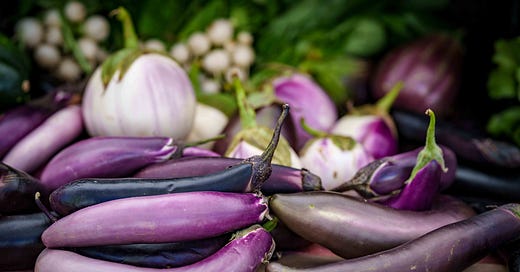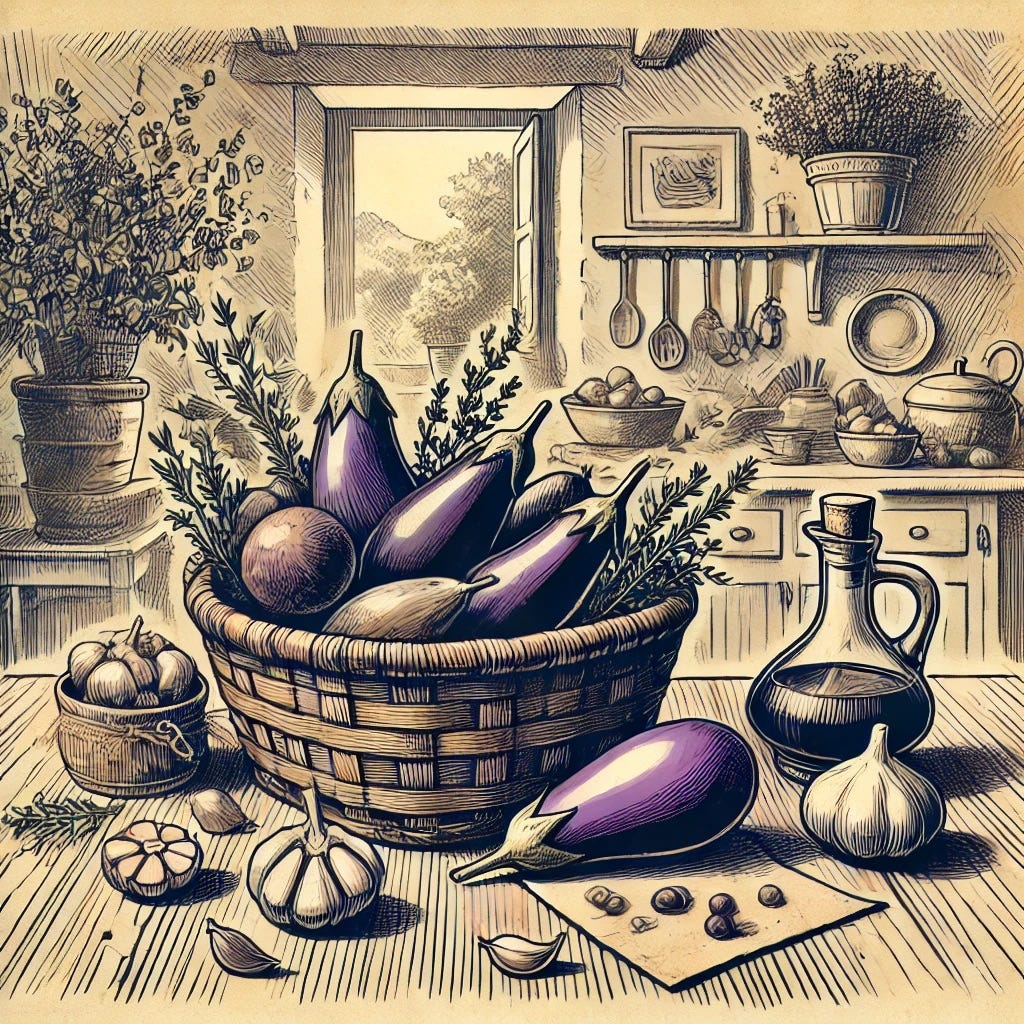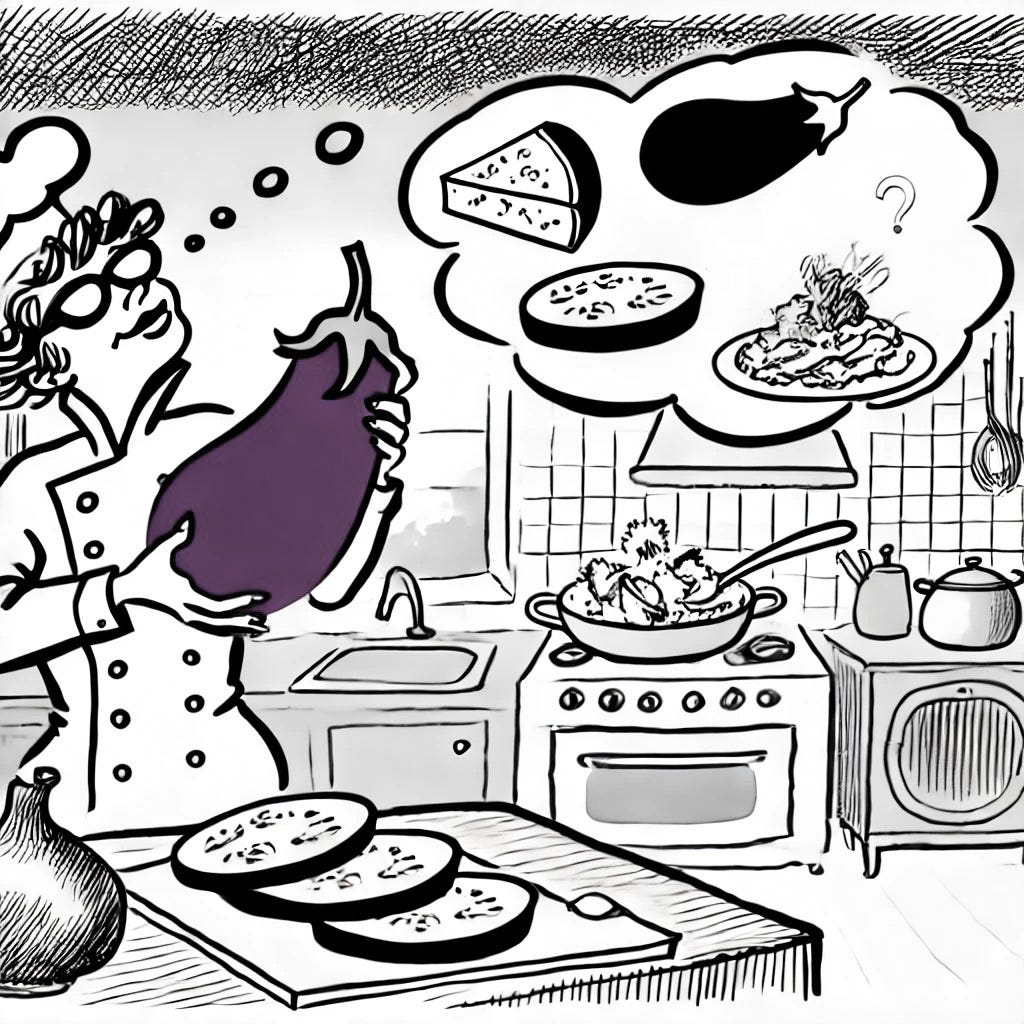NAPA VALLEY, Calif. — A shiny, dark-purple oval with a bulbous end and a rough green cap stood on the marble tabletop in the front of the classroom. Here, once a week, Miss Engman placed the still-life assignment for her third period art class, in which I was an intimidated ninth-grader. I had no idea what the purple thing was but thought it both beautiful and mysterious. As Miss Engman passed out sheets of light gray drawing paper and boxes of pastels, she explained that our assignment was to draw an eggplant, called an aubergine in French, and that it was a very popular vegetable in France and Italy, where, she told us, she had traveled often. Surely she told us where she had eaten it, maybe a trattoria in Florence or a restaurant in the south of France, near Nice or Cannes, and how it was prepared, but I don’t remember that part. Just the color and the strangeness.
It wasn’t until I went to New Joe’s Italian restaurant in San Francisco my senior year that I had an opportunity to taste eggplant. I eschewed the various pasta dishes, instead ordering whatever “eggplant parmesan” might turn out to be, anxious to join the ranks of European sophisticates whom I assumed ate such things on a daily basis.
I nibbled on the antipasti, wondering what the eggplant would taste like. Finally the white-aproned server arrived bearing a hot oval baking dish, bubbling with tomato sauce. With a flourish, he placed it in front of me. Somewhat dismayed, I saw no evidence of the purple vegetable I remembered from my art class. Only when I cut through the gratinéed top of the sauce, mozzarella cheese and breadcrumbs and reached the fried, meaty slices below did I see the purple edges that identified the eggplant. After a first tentative bite, fearful I would regret my choice, I embraced my discovery, finishing every morsel.
Provence and Seeds
When I was living in rural Provence in the early 1970s, raising goats and making cheese, my neighbors taught me how to cook eggplant — ratatouille, petits farcis, caponata, grilled, baked, pickled, even steamed — and they gave me advice on growing them.
“Set out the seedlings when the first oak leaves appear in May,” they said.
Later, when I co-founded an imported vegetable seed company, Le Marche Seeds, my partner, a botanist, and I imported eggplant seeds not only from Italy and France but also from Asia. We learned the different ways eggplants are used in the various cuisines of Asia, the Middle East and Africa, including stir-frying, satays, pickles, curries, tajines, moussaka, soups and stews.
At Home Today
Right now, as we slip from summer into fall, it is high eggplant season. I currently have a 25-foot row of them in my garden: round, lavender and white Italian ones; long, slender, Asian purple ones; and globes of a French variety. I still make my familiar dishes, beginning with eggplant parmesan, ratatouille, stir-fry with pork and sweet peppers, petits farcis stuffed with a savory beef mixture and moussaka. Soon I’ll make a few jars of eggplants packed in olive oil with thyme and garlic to keep in the refrigerator for a quick appetizer.
At the Restaurants
Napa’s restaurant kitchens are busy, too, with the abundance of eggplants. At Ciccio in Yountville you’ll find Fairytale Eggplant With Sweet and Sour Onions as a side dish. Auberge du Soleil presents a classic pairing of Spiced Lamb With Eggplant as a main dish and as a starter: Eggplant Caponata Stuffed Squash Blossoms (I might try making that at home). Charter Oak offers Grilled Koji Eggplant with Pickled Peppers from their Hearth menu.
Keeping it Simple
The possibilities appear to be limited only by the imagination. And if keeping it simple is your style, I heartily recommend slices of eggplant brushed with olive oil, seasoned with a little sea salt and then grilled until a crisp, golden skin — almost charred — forms on each side and the interior is creamy.
You can eat it as is on its own or as an accompaniment. Or fix an Italian street-food sandwich by putting a warm or room-temperature slice of the grilled eggplant between two slices of garlic mayonnaise-slathered bread plus a little lettuce.
No matter how you choose to eat your eggplant, now is the season for it.
EGGPLANT AND LAMB SKEWERS
If you happen to have access to fresh bay leaves, tuck these between the cubes of lamb and eggplant. I like to serve these with flatbreads, an herby salad and plain yogurt or with couscous and a tomato and sweet pepper salad.
Start to finish: 45 minutes
Servings: 6 skewers, 3 to 4
1 medium globe eggplant or 2 long eggplants, cut into ½-inch-thick cubes
1 ½ pounds boneless lamb shoulder or substitute beef rib-eye, cut into 1 to 1 ½ inch cubes
1 tablespoon extra-virgin olive oil
2 to 3 cloves garlic, minced
¼ cup minced onion
24 fresh sweet bay leaves or 2 dried
1 teaspoon sea salt
1 teaspoon freshly ground black pepper
½ teaspoon sweet paprika
6 metal or wooden skewers, soaked in water if wooden
Grapeseed or canola oil for the grill
In a bowl, combine the eggplant cubes and the meat with the olive oil, garlic and onion and dry bay leaf if using, and sprinkle with the salt, pepper and paprika. Turn several times and set aside to marinate for about 20 minutes.
On a skewer, slide a cube of eggplant, then a fresh bay leaf, if using, then a cube of meat. Continue until you have five meat cubes. Repeat the process with the other skewers.
Build a wood or charcoal fire in a barbeque or preheat a gas grill. When the grill or barbeque is ready, wipe the rack with the oil, place the skewers on the grill and cook until browning can be seen along the sides of the eggplant and meat, about 5 minutes. Turn and grill the other side. Push the meat with your finger. When it offers little or no resistance, about 5 more minutes.
Remove the skewers and serve immediately.
GRILLED EGGPLANT AND GARLIC CONDIMENT
My neighbor in Provence, who was from Calabria, Italy, made these every summer, using the wild thyme that grew on the hills and the eggplants and garlic from her son-in-law’s market garden. A bowl of the pickled eggplant alongside one of roasted preserved peppers was always on the table at lunch and dinner.
Start to finish: 35 minutes
Servings: 1 quart
¾ to 1 cup extra-virgin olive oil, divided use
4 eggplants, about ½ pound each, any type
2 tablespoons coarse sea salt
1 tablespoon freshly ground black pepper
6 garlic cloves, sliced paper thin
2 tablespoons chopped fresh thyme
¼ cup balsamic vinegar
¼ cup red wine vinegar
Build a wood or charcoal fire in a barbeque or preheat a gas grill or broiler. When the grill or barbeque is ready, wipe the rack with the oil. Cut the eggplants lengthwise into slices 3/8-inch thick. Cut these slices into long strips 1 inch wide. Brush the strips with 3 to 4 tablespoons of the olive oil and arrange them on a grill rack or broiler pan. Grill or broil them, turning once until golden, 3 to 5 minutes on each side. Remove and set aside until cool enough to handle, about 10 minutes.
Arrange a layer of eggplant in the bottom of a dry, sterilized wide-mouthed 1-quart jar with a lid. Sprinkle with some of the salt, pepper, garlic and thyme. Continue layering in the same manner until all the eggplant, garlic and thyme has been used. Combine the remaining olive oil and the two vinegars and pour over the eggplant layers. Cover with the lid. Place it in the refrigerator. Turn the jar upside down every other day for a week to allow the liquid to penetrate all the layers. At the end of the week the eggplant will be ready to eat, but the flavors will continue to develop with age. Store in the refrigerator for up to 5 months.
If today’s story captured your interest, explore these related articles:
The Historical (And Personal) Significance of Mexican Independence Day
Sunday E-dition: Frank Trozzo’s “IMAGINE THAT!” Art Show is a Fantastical Experience
Ray Ray’s Tacos Adds Spice to St. Helena’s Expanding Food Scene
Sunday E-dition: Mental Health Tips for Caregivers and Students
Sunday E-dition: End-of-Life Planning for Peace in Challenging Times
Sunday E-dition: Retired Judge Brings Real Napa Valley Crimes to Life
Sunday E-dition: WineaPAWlooza Raises $1.1 Million for Animals
Georgeanne Brennan is an award-winning cookbook author who divides her time between her farm in Northern California and a home in Provence. Learn more about her at georgeannebrennan.com.
Levity Corner
Caption contest: Pick your favorite caption or add your own in the comments below.
Possible captions:
"I didn’t know being delicious was a crime!"
"Are you seriously questioning my 'eggplant emoji' legacy?"
"Your Honor, today I represent the underserved."
"We vegetables have been on the chopping block for too long!"
"I've been grilled before, but never like this."
Last week’s contest results
In "Sunday E-dition: The AI Dilemma — Are Creatives Safe?” the winning caption was "I just feel so ... disconnected lately.” with 40% of the votes.
"I just feel so ... disconnected lately."
"It’s like I’m constantly running on low battery."
"I’ve been grinding gears over the smallest things lately."
"I keep over-analyzing my algorithms."
"I feel like I’m just a cog in the machine, you know?"
Last Week
Tim Carl highlighted Ballentine Vineyards' celebration of winemaker Bruce Devlin’s 25th anniversary in the article, "Ballentine Vineyards Celebrates Significant Milestone." Devlin’s dedication has helped the family-owned winery preserve its tradition while producing wines that reflect Napa Valley’s distinct terroir. Ballentine, known for its commitment to lesser-known varietals such as chenin blanc and malvasia bianca, maintains a focus on quality and affordability in an area dominated by high-priced cabernet sauvignon. Devlin emphasized letting the land guide winemaking choices, a philosophy central to the vineyard’s success.
Glenda Winders explored the impact of artificial intelligence on creative industries in her article "The AI Dilemma — Are Creatives Safe?" She reflected on how AI has quickly entered mainstream conversations, raising concerns about its potential to replace creative professionals, including writers and artists. Winders shared personal experiences and discussed both the benefits and challenges AI presents, while also citing experts who argue that AI could augment rather than replace jobs. Ultimately, she questioned whether AI will diminish human creativity or create new opportunities for it.
Cindy Watter discussed the dangers of poisonous plants in her article, "Pay Close Attention to Poisonous Plants." Reflecting on her own garden's growth of toxic pokeweed, she warned of the risks posed by common plants such as lilies, foxgloves and brugmansia to pets and children. Watter shared advice from veterinarians and emphasized that while some toxic plants might be medicinal in small doses, their presence in home gardens can be hazardous. She urged readers to consider safer plant alternatives to avoid potential harm to pets and family members.
Kathleen Scavone highlighted efforts to protect monarch butterflies in her article, "Monarchs and the Magic of Milkweed." She discussed the population decline of western monarchs due to habitat loss, pesticide use and climate change and emphasized the critical role of milkweed as their host plant. Erin Arnsteen of Monarch Joint Venture leads conservation efforts, working with various organizations to restore habitats and educate the public. Scavone encouraged planting milkweed to support monarchs and underscored the importance of pollinators in maintaining healthy ecosystems.
Tim Carl examined the intensifying pressures on Napa Valley's wine industry in his article, "Under the Hood: Heat Spike Intensifies Napa's Wine Industry Challenges." As the 2024 harvest wraps up, the region is grappling with a heat spike that threatens crop quality by accelerating dehydration and raising sugar levels. Compounding this, a sharp drop in consumer demand — especially among younger generations favoring craft beers and spirits — has led to a glut of unsold grapes and falling prices. With wineries struggling to sell their fruit, the heat wave and shifting market preferences are pushing Napa into a period of deep uncertainty.
Next Week
Next week we have more interesting articles from a host of Napa Valley Features contributors. Napa Climate NOW! will join the “Green Wednesday” posts with climate-focused insights alongside the U.C. Master Gardeners of Napa County’s horticultural advice. Dan Berger will bring his 42 years of wine-writing experience to Thursday’s Wine Chronicles with a focus on the current glut of wine. The Friday Weekender will highlight Napa Valley events, Rebecca Yerger will explore a 100-year celebration with her historic perspective and more.











I was raised with eggplant on the table whenever my mother could get it. I really enjoyed this piece. And, I plan to make some of these amazing recipes very soon. Thank you.
Loving Georgeanne’s contributions!